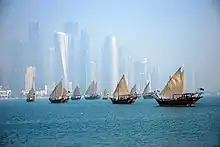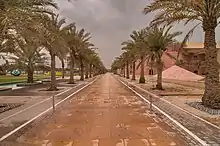Coat of arms of Qatar
The Coat of arms of Qatar (Arabic: شعار قطر) is the national emblem of the state of Qatar (Arabic: دولة قطر Dawlat Qatar). The Coat of arms was adopted six years after the termination of the British protectorate,[1] with the gained independence as a country under Sheikh Ahmad bin Ali Al Thani,[2] and was designed under the reign the Emir of Qatar Khalifa bin Hamad Al Thani in 1976.[2]
| Coat of arms of Qatar | |
|---|---|
 | |
| Armiger | Tamim bin Hamad Al Thani in Emir of Qatar |
| Adopted | 1976 |
| Supporters | Two scimitars |
| Motto | دولة قطر
or State of Qatar |
The emblem shows two crossed, white, curved swords in a yellow circle. Between the swords there is a sailing boat (Dhow) sailing on blue and white waves beside an island with two palm trees. The circle is surrounded by an additional circle, which is divided horizontally between the two colours of the flag. In the white section, the name of the state of Qatar is written in black and in Arabic, while in the maroon section, the country’s official name is written in a white old English font.
The official interpretation published by the Amiri Diwan (Sovereign body and the Administrative office)[3] is as follows.[2]
The Coat of Arms of the State of Qatar depicts a variety of meanings and values of different geographical and cultural connotations. It reflects an interactive and harmonious interface between wild and marine lives. It also depicts the palm tree height and its sense of giving, recalling of Arab mightiest swords, the sense of dignity and safe haven.
— Amiri Diwan, Coat of Arms of the State of Qatar
Design Influence from the flag of Qatar
The outer ring of the emblem is essentially the flag of Qatar This design was changed multiple times throughout Qatar’s history, and has been the same since 1960, when the final change happened under the rule of Sheikh Ali bin Abdullah Al Thani.[4] This followed with the US recognition of Qatar’s independence in 1971.[5] Qatar became such a large producer of this dye that it was referred to in the middle east as “Qatari maroon”.[1] This same maroon is used in the emblem for the outer halo, dhow, and palm trees.
The flag of Qatar has nine points at the separation point between the white and maroon, and the Coat of arms employs these nine points on each side of the outer halo.[2] These nine points signify Qatar’s introduction as the 9th member of the “Reconciled Emirates” in the wake of the Qatari-British treaty of 1916.[6] From 1972 - 2002, Bahrain's flag had eight points[7] and visually resembled the flag of Qatar, however Bahrain later changed theirs to have five points rather than eight, to symbolise the five pillars of Islam.[6] The original flag further resembled a shade of red, and the inclusion of the white stripe is believed to be a British directive during the time of the protectorate.[8]
- Evolution of the flag of Qatar.
 18th century -1860
18th century -1860.svg.png.webp) 1860-1916, 1916-1932
1860-1916, 1916-1932.svg.png.webp) 1916
1916.svg.png.webp) 1932-1936
1932-1936.svg.png.webp) 1936-1949
1936-1949.svg.png.webp) 1949-1971
1949-1971 1971-present
1971-present
National Colour of Qatar
.jpg.webp)
The national colour of the state of Qatar, outlined in 2015 by the Qatari government as 1955 C Maroon[9][10] is rooted in the origins of Qatar's history, and the factors that made it an independent nation. Being the first known place to mass produce shellfish dye, where large amounts were known to be initially found in Khor Ile-Sud, modern day Qatar.[11] The current colour used in the emblem and flag is the same to the original purple dye that was sourced, and distributed in Khor Ile-Sud.[11] The dye was obtained from the Murex snail and was known as "Tyrian purple".[12] Before the state of Qatar's conception, the purple dye was a valuable commodity and the area surrounding Al Khor Island and was under contention of the Sasanian Empire,[13] gaining control over much of the Persian Gulf.[14] In his History of Animals, Aristotle described the shellfish from which Tyrian purple was obtained and the process of extracting the tissue that produced the dye.[15]
The adoption of this maroon began with Sheikh Mohammed bin Thani in 1932, when Qatar shifted from using a more traditional red, which was too similar to the flag of the neighbouring country Bahrain.[6] This change allowed Qatar’s flag to become more distinguished, and also gave national identity to the new colour maroon that was then adopted,[1] as by 1932, the area in the Persian Gulf surrounding the city of Al Khor, referred to as Khor-Shaqiq,[11] was the largest source of the Tyrian purple shellfish dye in the world.[11]
Symbolism
The coat of arms of Qatar contains symbolic references to its history and culture, and each item in the emblem has some reference when looking at the inception of Qatar as an independent nation.
The Dhow

The dhow on the insignia is a reference to the pearling industry as the main factor in the stimulation of the economic and social growth of Qatar as a nation. [1] The boat played a large part in the creation of the state as an economically sound country and is to this day is a part of Qatar’s economic stability, with imports and exports in 2018 accounting for over 54% of the county’s GDP[16] thus making the state of Qatar financially reliant on the seas and their assets.[17]
During the ascendancy of the Abbasid caliphate in Baghdad, Qatar's surrounding bodies of water became famed for their riches, as the pearling industry grew larger, and the demand for Qatari pearl increased in the East, which extended as far as China.[18] These waters also became one of the main sources for the production of Tyrian Purple which had gained popularity throughout the East for its symbolic value in royalty and its artistic references from the likes of Theodoor van Thulden in Hercules' Dog Discovers Purple Dye.[19]
Two Date palms

With dates being the mainly cultivated fruit by the countries of the Middle East and North Africa,[20] Qatar officially recognises the two Date palms as a symbol of giving and the Arab dignity, with its height in the coat of arms being equal to that of the dhow, to reflect the state’s generosity in giving.[2] Qatar has also played a role in the research of the Phoenix dactylifera (date palm).[21] In 2009 a team of researchers from the Weill Cornell Medical College in Qatar published their findings on the Date palm Genome, by using "whole genome shotgun next generation DNA sequencing".[22] According to one of the researchers who had established the genomics laboratory in 2008[23]
"We have increased the publicly available knowledge of the date palm gene by about 1,000 fold."
— Weill Cornell Medicine, Qatar - Cornell University
Two Scimitars

Officially known as a Scimitar, it is known to be a depiction of Qatar’s "might as an Arab country" and a “safe haven” for its people.[2] The two crossed scimitars are a feature shared with the Emblem of Saudi Arabia, as is the palm tree, likely due to the weapon’s role in Arabian history, and the date palm being the most cultivated fruit in the Arab peninsula.[20] The curved sword or "scimitar" was widespread throughout the Middle East from at least the Ottoman period until the age of smokeless powder firearms had relegated swords to dress and ceremonial function. [24]
Additionally, the Arabian Scimitar has presence in Islamic history, with the most famed being that of Ali Ibn Abi Talib, the first imam in the Shia school of thought and fourth Sunni Caliph. [25] With Zulfiqar being the name of the double bladed sword that was wielded by Ali, as depicted by Islamic scholars. [24][25]
Usage
The Coat of Arms of Qatar is used across departments of government and in official documents, it's mark is a symbol of authority and power used by various bodies of government. The emblem carries presence in statutory and non-statutory authorities included. The current Qatar emblem can be found on the front of the Qatari passport, birth certificates, some official university documents and other non-official documents used throughout the state.
Additionally, the emblem is printed on Qatari riyal notes, and embossed on the Hamad and Tamim coins.[26]
Different parts of the emblem are occasionally used independently in different government branches. The two crossed scimitars are used in the Qatar Armed Forces for the types of Military ranks of the state.[27] As per the states rank insignia's, the highest ranking officials in the Navy and Air Force are those with the two crossed scimitars taken from the Coat of Arms. [28] [29]
References
- Zahlan, Rosemarie Said (1979). The creation of Qatar. Harper & Row Publishers, Taylor & Francis. pp. 20–25.
- "Key Facts and Information About the State of Qatar | The Amiri Diwan". www.diwan.gov.qa. Retrieved 2020-11-18.
- Diwan, Amiri. "About Amiri Diwan". www.diwan.gov.qa. Retrieved 2020-11-22.
- Crampton, W.G. (1989). The complete Guide to flags. Gallery books. pp. 78–79.
- "A Guide to the United States' History of Recognition, Diplomatic, and Consular Relations, by Country, since 1776: Qatar". Office of the Historian. Retrieved 2020-12-18.
- "The World Factbook — Central Intelligence Agency". 2017-07-01. Archived from the original on 2017-07-01. Retrieved 2020-12-06.
- Complete flags of the world (New ed.). London. 2014. ISBN 978-1-4093-5371-3. OCLC 876288922.
- "Qatar Protectorate". www.britishempire.co.uk. Retrieved 2021-01-02.
- "Qatari Fla g". WorldAtlas. Retrieved 2021-01-02.
- "What Do The Colors And Symbols Of The Flag Of Qatar Mean?". WorldAtlas. Retrieved 2020-11-19.
- Edens, Christopher (1999). "Khor Ile-Sud, Qatar: The Archaeology of Late Bronze Age Purple-Dye Production in the Arabian Gulf". Iraq. 61: 71–88. doi:10.2307/4200468. ISSN 0021-0889. JSTOR 4200468.
- "History of Qatar" (PDF). www.qatarembassy.or.thv. Ministry of Foreign Affairs. Qatar. London: Stacey International, 2000. 2020-12-26.
- "Qatar - History". www.globalsecurity.org. Retrieved 2021-01-01.
- Cadène, Philippe; Dumortier, Brigitte, Atlas of the Gulf states, Boston, ISBN 978-90-04-24566-2, OCLC 862122228, retrieved 2021-01-03
- Thompson, D'Arcy W. History of animals. United States. ISBN 978-1-4191-2391-7. OCLC 1050082874.
- "Qatar (QAT) Exports, Imports, and Trade Partners". The Observatory of Economic Complexity (OEC). Retrieved 2020-11-15.
- "Excavations at MR11 on Marawah Island (Abu Dhabi, UAE): new insight into the architecture and planning of Arabian Neolithic settlements and early evidence for pearling". Arabian Archaeology and Epigraphy. 2 (3). doi:10.1111/aae.1991.2.issue-3. ISSN 0905-7196.
- "Qatar - Early History". www.globalsecurity.org. Retrieved 2021-01-01.
- Lewis, Sian; Llewellyn-Jones, Lloyd. The culture of animals in antiquity a sourcebook with commentaries. London. ISBN 978-1-351-78249-4. OCLC 1124388166.
- "FAOSTAT - Elements: Production Quantity / Items: Dates". Food and Agriculture Organisation of the United Nations. Retrieved 2020-12-13.
- Diwan, Amiri. "About Amiri Diwan". www.diwan.gov.qa. Retrieved 2020-11-22.
- Crampton, W.G. (1989). The complete Guide to flags. Gallery books. pp. 78–79.
- "A Guide to the United States' History of Recognition, Diplomatic, and Consular Relations, by Country, since 1776: Qatar". Office of the Historian. Retrieved 2020-12-18.
- Alexander, David (2001-12-30). "SWORDS AND SABERS DURING THE EARLY ISLAMIC PERIOD". Gladius. XXI (1): 193–219. doi:10.3989/gladius.2001.86. ISSN 1988-4168.
- Lindsay, James E., 1957- (2005). Daily life in the medieval Islamic world. Westport, Conn: Greenwood Press. ISBN 0-313-32270-8. OCLC 61253806.CS1 maint: multiple names: authors list (link)
- "Monetary System in Qatar Historical Background". www.qcb.gov.qa. Retrieved 2021-01-15.
- "Rank Insignia State of Qatar". www.uniforminsignia.org. Retrieved 2021-01-14.
- "RANK INSIGNIA - NAVY & COAST GUARD OF QATAR". www.uniforminsignia.org. Retrieved 2021-01-14.
- "RANK INSIGNIA - AIR FORCES & AVIATIONS OF QATAR". www.uniforminsignia.org. Retrieved 2021-01-14.
External links
- Embassy of Qatar in Washington DC
- FOTW - Qatar
- The banknotes of Qatar (in English and German)
